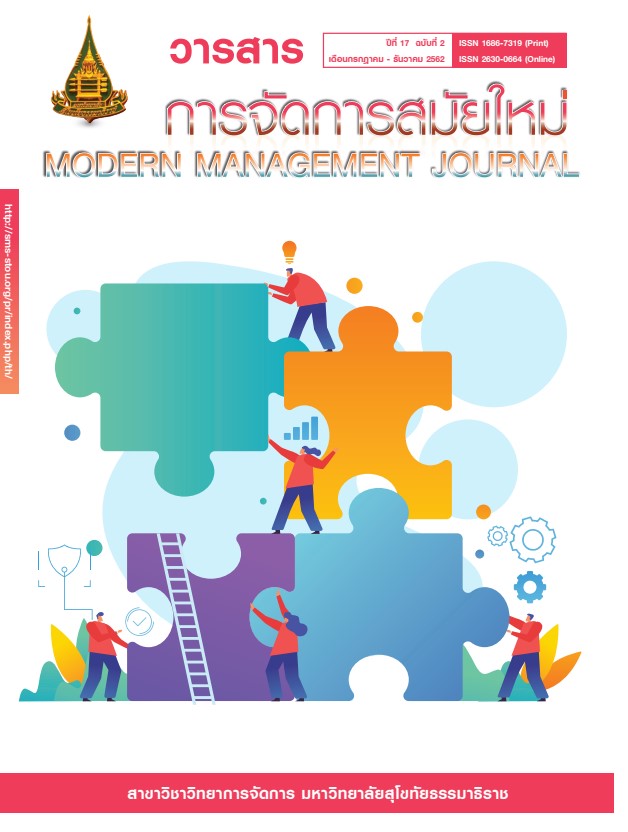FINANCIAL MANAGEMENT MODEL BY USING INFORMATION SYSTEM OF ORGANIC SALTED SOYA BEAN PRODUCERS GROUP
Keywords:
Financial management, Organic agricultural, Information system, Organic Salted Soya BeanAbstract
Financial Management model by using information system for organic salted soya producers groups at Bandon Chiang, Maetaeng District, Chiang Mai Province. The objectives are studying financial management model and studying financial development by using information system for salted soya bean Producers Group. The results show: Part 1 financial management for Salted Soya Bean Producers Group consist of 1.1) financial planning, the group lacks of formal financial planning, 1.2) financing, the group is only have own capital. 1.3) investment, the group invests in current assets and fixed assets, and 1.4) financial controlling, the group does not have financial controlling. Part 2 financial development model by using Microsoft Excel Program consist of 2.1) financial planning and financial budgeting 2.2) financial recording and financial reporting, and 2.3) financial controlling. This financial development model can solve the mistake about total summary number and save time to calculation. Moreover, the Salted Soya Bean Producers Group can make financial decision by using financial analysis to develop and improve the operation performance efficiently.
References
Ang, J. S. (1992). On the theory of finance for privately held firms. The Journal of Small Business Finance, 1(3), 185-203.
Berger, A. N., & Udell, G. F. (1998).The economics of small business finance: The roles of private equity and debt markets in the financial growth cycle. Journal of Banking & Finance, 22, 613-673.
Caneghem, T. V., & Campenhout, G. V. (2010). Quantity and quality of information and SME financial structure. Springer Science Business Media. Published online: 24 November 2010.
Cassar, G. (2004). The financing of business start-ups. Journal of Business Venturing, 19, 261–283.
Chaipinchana, P. ( 2016) The financial management development of The organic Nong Pa Krung Group in Nong Pa Krung Sub-district, muang district, Chiang Mai province. Journal of Community Development and Life Quality. 4(1), 84 - 97.
Deesomsak, R., Paudyal, K., &Pescetto, G. (2004). The determinants of capital structure: evidence from the Asia Pacific region. Journal of Multinational Financial Management, 14, 387-405.
Fatoki, O. O., & Asah, F. (2011). The impact of firm and entrepreneurial characteristics on access to debt finance by SMEs in King Williams’ Town, South Africa. International Journal of Business and Management, 6 (8),170-179.
Frelinghaus, A., Mostert, B., & Firer, C. (2005). Capital structure and the firm’s life stage. South African Journal of Business Management, 36 (4), 9-18.
García‐Teruel, P.J., & Martínez‐Solano, P. (2007). Effects of working capital management on SME profitability. International Journal of Managerial Finance, 3 (2), 164-177.
Gitman, L.J. (2003). The principles of managerial finance. New York: Pearson Education Inc.
Green Net (2018) Thai Organic 2017/18: Leap Jump but will it be sustainable.https://www.greennet.or.th/en/article/1980.
Hall, G., Hutchinson, P., & Michealas, N. (2000). Industry effect on the determinants of Unquoted SMEs Capital Structure. International Journal of the Economic of Business, 7(3), 297-312.
Misomnai, C. (2013). Fundamentals of management: essential concepts and applications 8th edition (Global Edition). Modern Management Journal, 12 (1), 110-116.
Noisopha. S (2015). “Organic Agriculture” An opportunity for Thailand to export and set foot in the World Market. Journal of Thonburi University, 9(18), 83-91.
Rigby, D., & Caaceres, D. (2001). Organic farming and the sustainability of agricultural systems. Agricultural Systems, 68(1), 121-40.
Romano, C.A., Tanewski, G.A., &, Smyrnios, K. S. (2001). Capital structure decision making: A model for family business. Journal of Business Venturing, 16 (3), 285-310.
Sathaworawong, S. (2011) A study of patterns and design of fund accounting System and financial management based on the missions of Sukhothai Thammathirat Open University. Modern Management Journal, 9 (2), 28-40.
Tulasombat, S. (2006). The increasing sustainable strengthen of financial for organic agricultural farmer Group. Maejo University. Chiangmai.
Yapan, P. (2011). The Demand Management of raw materials and resources in the production process by using Microsoft Excel.(Unpublished Master Thesis) University of the Thai Chamber of Commerce. Bangkok.



